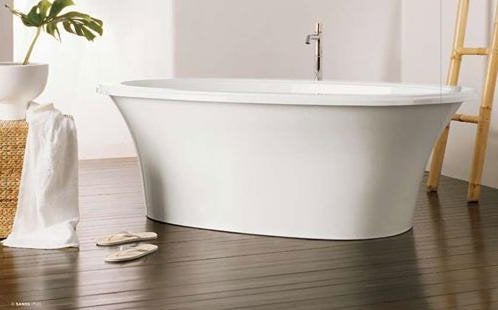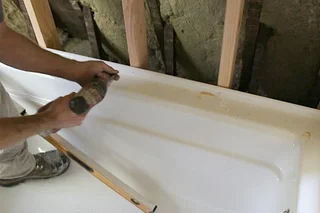What are your thoughts about How to Install a Bathtub Yourself?

Mounting a bath tub isn't exactly rocket science, yet it does require solid plumbing, woodworking, and also sometimes, tiling skills. Changing an old bath tub with a new one is additionally a reasonably challenging project. If the old tub is easily obtainable, the project can move quickly; if you have to open a wall to remove the old tub as well as position the new bathtub, the task is much harder. In either case, the project is within a home handyman's skills, although you will need a helper to move out the old tub and embeded in the new one. Ensure you have certified on your own for the work as well as are comfortable trying it. As opposed to employing a professional to take control of a halfway-completed job, it is better to consider utilizing one before you start. Possibilities are you might require an expert plumber to make tube connections.
This write-up will certainly assist you set up a new bathtub in your bathroom if you have actually currently purchased a new tub as well as don't need to change the setup of your previous water pipelines.
Your devices as well as material list must make up the following:
Planning for the Setup
First of all, the supporting frame provided with the bathroom must be fitted (if required) according to the manufacturer's guidelines. Next, fit the taps or mixer to the bath tub. When suitable the faucet block, it is essential to make sure that if the tap comes with a plastic washing machine, it is fitted between the bath and also the faucets. On a plastic bath, it is also reasonable to fit a sustaining plate under the taps unit to stop stress on the tub.
Fit the flexible faucet ports to the bottom of the two faucets utilizing 2 nuts as well as olives (sometimes provided with the tub). Fit the plug-hole outlet by smearing mastic filler round the sink electrical outlet hole, and afterwards pass the outlet via the hole in the bath. Make use of the nut supplied by the supplier to fit the plug-hole. Take a look at the plug-hole outlet for an inlet on the side for the overflow pipeline.
Next, fit completion of the versatile overflow pipe to the overflow electrical outlet. After that, screw the pipe to the overflow face which must be fitted inside the bath. See to it you utilize every one of the provided washers.
Attach the trap to the bottom of the waste electrical outlet on the tub by winding the thread of the waste electrical outlet with silicone mastic or PTFE tape, and also screw on the trap to the electrical outlet. Link all-time low of the overflow tube in a similar manner.The bathroom ought to currently be ready to be suited its final placement.
Removing Old Taps
If you require to replace old taps with brand-new ones as a part of your installation, after that the first thing you should do is detach the water. After doing so, activate the taps to drain pipes any water continuing to be in the system. The process of getting rid of the existing taps can be rather bothersome due to the restricted gain access to that is often the case.
Utilize a container wrench (crowsfoot spanner) or a faucet tool to undo the nut that attaches the supply pipes to the taps. Have a fabric all set for the remaining water that will originate from the pipelines. As soon as the supply pipes have been eliminated, utilize the very same device to loosen the nut that holds the faucets onto the bath/basin. You will need to stop the single taps from transforming throughout this procedure. Once the taps have been eliminated, the holes in the bath/basin will have to be cleaned up of any kind of old securing compound.
Before proceeding to fit the new taps, contrast the pipeline links on the old taps to the new faucets. If the old faucets are longer than the new faucets, then a shank adapter is required for the new taps to fit.
Setting up the Bath tub
Making use of both wood boards under its feet, position the tub in the called for placement. The wood boards are handy in evenly spreading the weight of the bathtub over the area of the boards instead of concentrating all the weight onto 4 small factors.
The following objective is to make certain that the bath tub is leveled all round. This can be attained by examining the level as well as changing the feet on the tub up until the spirit level checks out level.
To set up taps, fit all-time low of the outermost adaptable faucet port to the proper supply pipeline by making a compression join; then do the same for the other tap.
Switch on the water system as well as inspect all joints as well as new pipework for leaks and tighten them if needed. Fill up the tub and also check the overflow electrical outlet as well as the typical outlet for leakages.
Lastly, repair the bath paneling as described in the supplier's user's manual. Tiling as well as sealing around the bath tub needs to wait up until the tub has actually been utilized at least once as this will certainly resolve it into its last setting.
Fitting New Touches
If the tails of the new taps are plastic, after that you will certainly need a plastic connector to avoid damage to the string. One end of the port fits on the plastic tail of the tap and also the various other end offers a connection to the current supply pipelines.
If you need to fit a monobloc, after that you will call for minimizing couplers, which connects the 10mm pipeline of the monobloc to the common 15mm supply pipe.
Next off, position the faucet in the placing hole in the bath/basin ensuring that the washers are in area between the faucet and the sink. Safeguard the tap in position with the maker offered backnut. As soon as the tap is safely in place, the supply pipelines can be connected to the tails of the faucets. The taps can either be connected by utilizing corrugated copper piping or with normal faucet connectors. The former kind must be connected to the faucet ends initially, tightening just by hand. The supply pipes can later be attached to the other end. Tighten up both ends with a spanner after both ends have been attached.
Tiling Around the Bath tub
In the area where the bathroom satisfies the floor tile, it is required to secure the joins with a silicone rubber caulking. This is necessary as the installation can relocate enough to fracture a stiff seal, creating the water to pass through the wall in between the bath as well as the tiling, leading to issues with dampness as well as feasible leakages to the ceiling below.
You can select from a selection of coloured sealants to blend in your components and also fittings. They are marketed in tubes and cartridges, as well as can sealing spaces approximately a width of 3mm (1/8 inch). If you have a bigger void to fill, you can fill it with twists of drenched newspaper or soft rope. Keep in mind to constantly fill the tub with water prior to securing, to permit the movement experienced when the tub is in usage. The sealer can split rather early if you do not think about this movement before securing.
Conversely, ceramic coving or quadrant tiles can be used to border the bathroom or shower tray. Plastic strips of coving, which are easy to use and also cut to size, are likewise conveniently available on the market. It is recommended to fit the ceramic tiles making use of waterproof or waterproof adhesive and also grout.
Bathtub Installation
How Important Is A Bathtub To Your Home?
High-quality baths, showers, and other bathroom updates are necessary when considering a smart investment in your home. It’s a room that you go to every day and one that is constantly being used by guests.The bathroom is one of the top trafficked rooms in a home and also one of the most valuable in terms of home resale.
Install Piping Before Tub
You will be using your existing drain and waste vent system, but pipes required include the hot and cold water supply lines and a pipe leading to a shower head. A mixing valve and shower head are also needed. Air chambers may be required.
Position the Tub
Lower the tub into place so that the continuous flange fits against the wall studs and rests on 1’x4' or 2’x4' supports. Anchor the tub to the enclosure with nails or screws inserted through the flanges into the studs.
NOTE: Remember, bathtubs and shower stalls may require support framing. A bathtub filled with water is extremely heavy, so check building codes and framing support before installing the tub.
Assemble Drain Connections
Assemble the bathtub drain connections by connecting the tub overflow with the tub drain above the trap, not beyond it. The trap will have a compression fitting that screws over the arm of the overflow assembly.
Place a Pipe For the Shower Head
First, locate a brass female threaded winged fitting and attach it to a framing support via a screw or a nail. Then run a pipe up the wall for the shower head. Sweat or solder the other side of the brass fitting to the top of the pipe.
Attaching Hot and Cold Water Lines
Attach your water lines for both hot and cold by sweating these directly into the hot and cold ports of the mixing valve. The mixing valve will be how water enters the tub’s system, not by the pipes themselves.
Install the Spout
Extend a piece of 1/2 inch pipe, or whichever length is specified in the manufacturer’s instructions, for the tub spout. Sweat on a male threaded fitting at the end of the pipe or use a brass nipple of the proper length and a 1/2 inch cap.
NOTE: At this point you should have your rough-in plumbing work inspected before proceeding further.
Check For Leaks
Restore the water pressure and check the drain connection and the supply pipes for any sign of leaking.
estore the Bathroom Wall
Replace the wall with moisture-resistant drywall as a base for your wall covering. Seal the joints between the wall and your new tub with silicone caulk as protection against water seepage.
https://www.berkeys.com/2016/12/02/bathtub-installation-dallas/

I am just very excited about How to Install a Bathtub and I am praying you enjoyed reading our piece. Liked our piece of writing? Please share it. Help someone else locate it. Thank-you for your time invested reading it.
Book Instantly